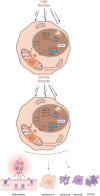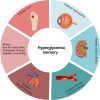An update on chronic complications of diabetes mellitus: from molecular mechanisms to therapeutic strategies with a focus on metabolic memory
- PMID: 38797859
- PMCID: PMC11128119
- DOI: 10.1186/s10020-024-00824-9
An update on chronic complications of diabetes mellitus: from molecular mechanisms to therapeutic strategies with a focus on metabolic memory
Abstract
Diabetes mellitus, a chronic metabolic disease, often leads to numerous chronic complications, significantly contributing to global morbidity and mortality rates. High glucose levels trigger epigenetic modifications linked to pathophysiological processes like inflammation, immunity, oxidative stress, mitochondrial dysfunction, senescence and various kinds of cell death. Despite glycemic control, transient hyperglycemia can persistently harm organs, tissues, and cells, a latent effect termed "metabolic memory" that contributes to chronic diabetic complications. Understanding metabolic memory's mechanisms could offer a new approach to mitigating these complications. However, key molecules and networks underlying metabolic memory remain incompletely understood. This review traces the history of metabolic memory research, highlights its key features, discusses recent molecules involved in its mechanisms, and summarizes confirmed and potential therapeutic compounds. Additionally, we outline in vitro and in vivo models of metabolic memory. We hope this work will inform future research on metabolic memory's regulatory mechanisms and facilitate the development of effective therapeutic compounds to prevent diabetic complications.
Keywords: Diabetic complications; Metabolic memory; Models of metabolic memory; Molecular mechanisms; Treatment progress.
© 2024. The Author(s).
Conflict of interest statement
The authors declare no conflicts of interest that pertain to this work.
Figures



Similar articles
-
Update: the role of epigenetics in the metabolic memory of diabetic complications.Am J Physiol Renal Physiol. 2024 Sep 1;327(3):F327-F339. doi: 10.1152/ajprenal.00115.2024. Epub 2024 Jul 4. Am J Physiol Renal Physiol. 2024. PMID: 38961840 Review.
-
Epigenetic modifications in metabolic memory: What are the memories, and can we erase them?Am J Physiol Cell Physiol. 2022 Aug 1;323(2):C570-C582. doi: 10.1152/ajpcell.00201.2022. Epub 2022 Jul 4. Am J Physiol Cell Physiol. 2022. PMID: 35785987 Free PMC article. Review.
-
Metabolic memory phenomenon in diabetes mellitus: Achieving and perspectives.Diabetes Metab Syndr. 2016 Apr-Jun;10(2 Suppl 1):S176-83. doi: 10.1016/j.dsx.2016.03.016. Epub 2016 Mar 16. Diabetes Metab Syndr. 2016. PMID: 27025794 Review.
-
Glycemic memory associated epigenetic changes.Biochem Pharmacol. 2010 Dec 15;80(12):1853-9. doi: 10.1016/j.bcp.2010.06.005. Epub 2010 Jun 19. Biochem Pharmacol. 2010. PMID: 20599797 Review.
-
Metabolic memory: Evolving concepts.J Diabetes. 2018 Mar;10(3):186-187. doi: 10.1111/1753-0407.12622. Epub 2017 Dec 11. J Diabetes. 2018. PMID: 29091343
Cited by
-
Predicting isolated impaired glucose tolerance without oral glucose tolerance test using machine learning in Chinese Han men.Front Endocrinol (Lausanne). 2025 Apr 24;16:1514397. doi: 10.3389/fendo.2025.1514397. eCollection 2025. Front Endocrinol (Lausanne). 2025. PMID: 40343071 Free PMC article.
-
K. pneumoniae-induced septic embolism and prostatic abscesses in a treatment-naive type 2 diabetic patient: a case report.BMC Infect Dis. 2025 Jul 1;25(1):838. doi: 10.1186/s12879-025-11274-x. BMC Infect Dis. 2025. PMID: 40597794 Free PMC article.
-
The Role of Pro-Inflammatory Chemokines CCL-1, 2, 4, and 5 in the Etiopathogenesis of Type 2 Diabetes Mellitus in Subjects from the Asir Region of Saudi Arabia: Correlation with Different Degrees of Obesity.J Pers Med. 2024 Jul 11;14(7):743. doi: 10.3390/jpm14070743. J Pers Med. 2024. PMID: 39063997 Free PMC article.
-
Association of total cholesterol to high-density lipoprotein cholesterol ratio with diabetes risk: a retrospective study of Chinese individuals.Sci Rep. 2025 May 9;15(1):16261. doi: 10.1038/s41598-025-87277-0. Sci Rep. 2025. PMID: 40346160 Free PMC article.
-
Ginsenoside in the treatment of type 2 diabetes and its complications: a promising traditional chinese medicine.Front Pharmacol. 2025 May 13;16:1593780. doi: 10.3389/fphar.2025.1593780. eCollection 2025. Front Pharmacol. 2025. PMID: 40432897 Free PMC article. Review.
References
Publication types
MeSH terms
Grants and funding
LinkOut - more resources
Full Text Sources
Medical

